Rotator Cuff Injury Exercises
Medically reviewed by Drugs.com. Last updated on Jun 30, 2025.
What do I need to know about rotator cuff injury exercises?
Exercises help improve shoulder movement and strength, and decrease pain. Your physical therapist or healthcare provider will tell you when to start doing the exercises. He or she will tell you how often to do them. You will need to start slowly to prevent more injury. You will move through several levels over time as you get stronger and more flexible.
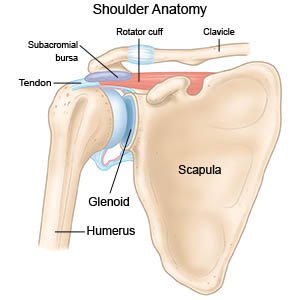 |
What are some safety guidelines to follow?
- Always warm up before you do the exercises. Walk or ride a stationary bike for 5 to 10 minutes to help you warm up.
- Do not put your arm over your head until directed. You will need to wait until your injury has healed. The movement of some exercises could continue until your arm is over your head. You will need to stop the movement where directed.
- Stop if you feel pain. You may feel some tight or stiff areas when you start. This should get better as you continue the exercises. You should not feel pain. Pain means you are not ready to do the exercise yet. Stop and call your physical therapist or healthcare provider right away.
- Always work both rotator cuffs. Even if your injury is only on 1 side, it is important to do each exercise on both sides. This helps prevent injury and maintain balance in your shoulders and back.
- Use correct posture. Your physical therapist or healthcare provider will show you the proper posture for each exercise. You will be shown how to pull your shoulders back and down to engage the correct muscles. Remember not to let your shoulders shrug during an exercise unless it is part of the movement.
How should I do stretching exercises?
You will not feel every exercise in your shoulder area. You may feel some of the stretches in your back, side, or upper arm muscles. You need to work muscles in and around your rotator cuffs and down your arms. This helps stabilize your shoulders. Your physical therapist or healthcare provider will tell you how long to hold each stretch. He or she will also tell you how many times to repeat each stretch during an exercise session. You may be told to do only certain exercises, or to do them in a specific order. The following are general directions to help you remember the exercises you are taught:
- Pendulum swings: Lean forward and rest your arm on a table. Do not round your back or lock your knees during the exercise. Let your other arm hang freely by your side. Gently swing your free arm forward and backward, side to side, and in circles.

- Crossover arm stretch: Relax your shoulders. Hold your upper arm with the opposite hand. Pull your arm across your chest until you feel a stretch. Hold the stretch. Return to the starting position.
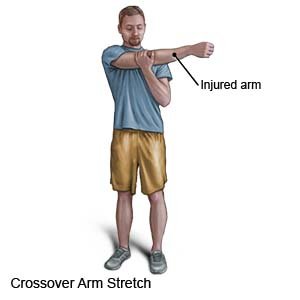
- Sleeper stretch: Lie on your side on a firm, flat surface. Bend the elbow of your top arm 90°. Use your other hand to slowly push your arm down. Stop when you feel a stretch at the back of your shoulder. Hold the stretch. Slowly return to the starting position.
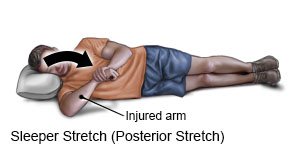
- Shoulder movement, up and down: This exercise may also be called shoulder extension. Sit in a chair that has a back but no armrests. Raise your arm like you are reaching for the wall in front of you. Continue to raise the arm until it is over your head, or as high as directed. Bring your arm back down to your side. Bring it back as far as possible behind your body. Return your arm to the starting position.
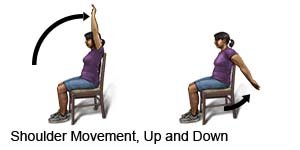
- Shoulder movement, side to side: These movements may be called flexion, internal rotation, and external rotation. Sit in a chair that has a back but no armrests. Raise your arm to the side and then up over your head as far as directed. Return your arm to your side. Bring your arm across the front of your body and reach for the opposite shoulder. Return your arm to the starting position.
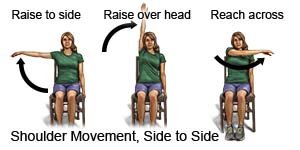
- Shoulder rolls: Stand and raise both shoulders toward your ears. Lower them to the starting position. Relax your shoulders. Pull your shoulders back. Then relax them again. Roll your shoulders in a smooth circle. Then roll your shoulders in a smooth circle in the other direction.
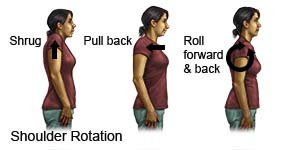
- Wall reach exercise: This may also be called a flexion stretch. Stand facing a wall. Slowly walk your fingers up the wall until you feel a stretch. Hold the stretch. Return to the starting position.
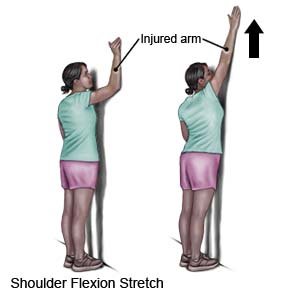
- Arm reach exercise: Lie on your back with your legs straight. Reach your arms like you are trying to touch the ceiling. Reach as high as you can so you feel a stretch in the back of your arms. Hold the stretch. Then lower your arms to your sides.
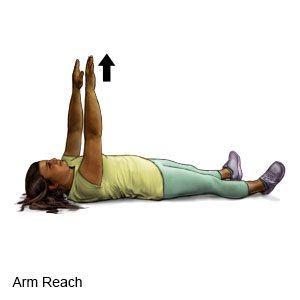
- Elbow bends: Stand with your arms down to your sides. Keep your palm facing forward. Bend your elbow and try to touch your shoulder with your fingertips. Return your arm to the starting position.
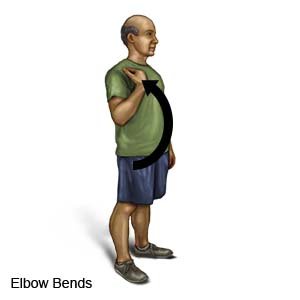
- Up the back stretch: Stand and put both arms behind your back. Put one hand under the other. Move the bottom hand and slowly push the upper hand up toward your head. You should feel a stretch in the front of your arm and shoulder. Be careful not to push too hard. Hold the stretch. Then return to the starting position.
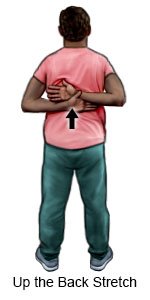
- Triceps stretch: Stand and drop your forearm down your back so your hand is pointing to the ground behind you. Your elbow should be pointing at the ceiling. Take your other hand and place it on your elbow. Gently and slowly push on the elbow until you feel a stretch in the back of your arm. Hold the stretch. Let go of your elbow and relax your arm. You may be shown how to do this stretch with a towel. The towel can be pulled gently with a hand behind your back at waist level.
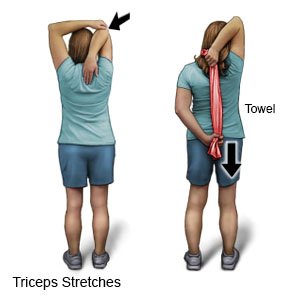
How should I do strengthening exercises?
Strengthening exercises may include handheld weights or resistance bands. Your physical therapist or healthcare provider will tell you how much weight or resistance to use. The general guide is to use light weights or low resistance and to do a high number of repetitions. You may be told to do only certain exercises, or to do them in a specific order. The following are general directions to help you remember the exercises you are taught:
- Scapular squeeze: Stand with your arms at your sides. Squeeze your shoulder blades together and hold this position. Then relax the muscles. Keep your shoulder back during the entire exercise.
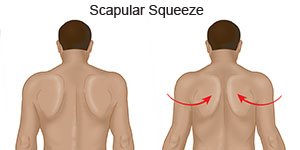
- Wall pushups: This exercise is similar to a pushup done on the ground. The goal is to use your back and shoulder muscles to bring your upper body toward and away from the wall. Stand facing a wall. Put your hands on the wall. Bend your elbows to bring your upper body toward the wall. Straighten your arms to return to the starting position. Keep your feet close enough to the wall that you do not take a step when you bend your elbows.
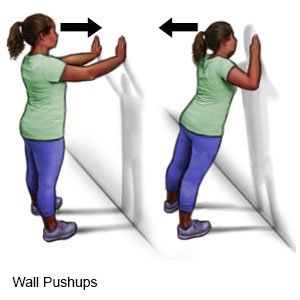
- Standing row with exercise band: Wrap the exercise band around a heavy, stable object at waist level. Make loop in the end of the band to create a handle, if needed. Hold the handle or loop and pull the band straight back toward your hip. Keep your shoulder down. Squeeze your shoulder blade. Hold this position. Then slowly return to the starting position.
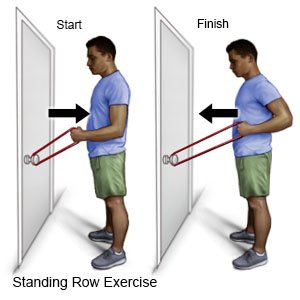
- External rotation with arm abducted 90 degrees: Wrap the exercise band around a heavy, stable object at waist level. Make loop in the end of the band to create a handle, if needed. Stand and hold the handle or loop. Bend your elbow and raise your arm to shoulder height. Keep your arm in this position. Raise your hand like you are pointing at the ceiling. Slowly return to the starting position. You may also be shown how to do this exercise lying down and with a weight.
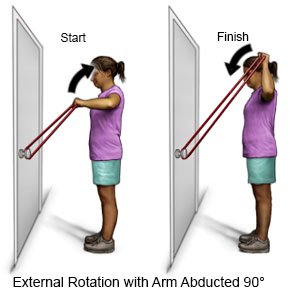
- Shoulder abduction with weight: Stand and hold a weight in your hand with your palm facing your body. Slowly raise your arm to the side with your thumb pointing up. Then raise your arm as far as you can without pain. Hold this position. Then return to the starting position.
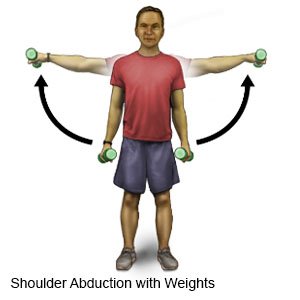
- Shoulder abduction with exercise band: Wrap the exercise band around a heavy, stable object near your foot. Grab the band. Keep your arm straight. Slowly raise your arm to the side with your thumb pointing up. Then, slowly pull the band as far as you can without pain. Slowly return to the starting position.
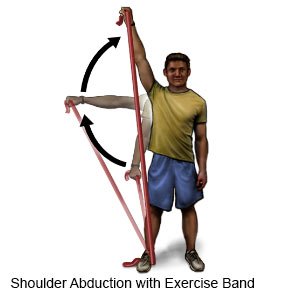
- Shoulder adduction with weight: Lie on your back on a firm surface. Hold a weight in your hand at your shoulder. Slowly raise your arm toward the ceiling and straighten your elbow. Hold this position. Then slowly return to the starting position.
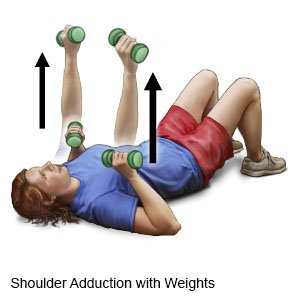
- Shoulder adduction with exercise band: Wrap the exercise band around a heavy, stable object. Stand and face away from where the band is anchored. Hold each end of the band in both hands with your elbows bent. Your elbows should not be behind your body. Keep your arms parallel to the floor and slowly straighten your elbows. Hold this position. Slowly return to the starting position.
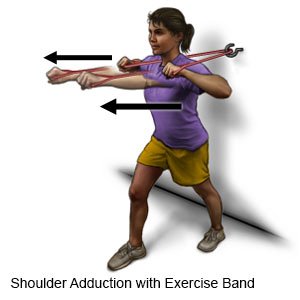
When should I call my doctor or physical therapist?
- You have sharp or worsening pain during exercise or at rest.
- You have questions or concerns about your rotator cuff injury exercises.
Care Agreement
You have the right to help plan your care. Learn about your health condition and how it may be treated. Discuss treatment options with your healthcare providers to decide what care you want to receive. You always have the right to refuse treatment. The above information is an educational aid only. It is not intended as medical advice for individual conditions or treatments. Talk to your doctor, nurse or pharmacist before following any medical regimen to see if it is safe and effective for you.© Copyright Merative 2025 Information is for End User's use only and may not be sold, redistributed or otherwise used for commercial purposes.
Further information
Always consult your healthcare provider to ensure the information displayed on this page applies to your personal circumstances.
